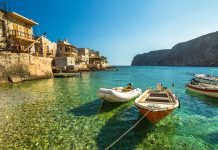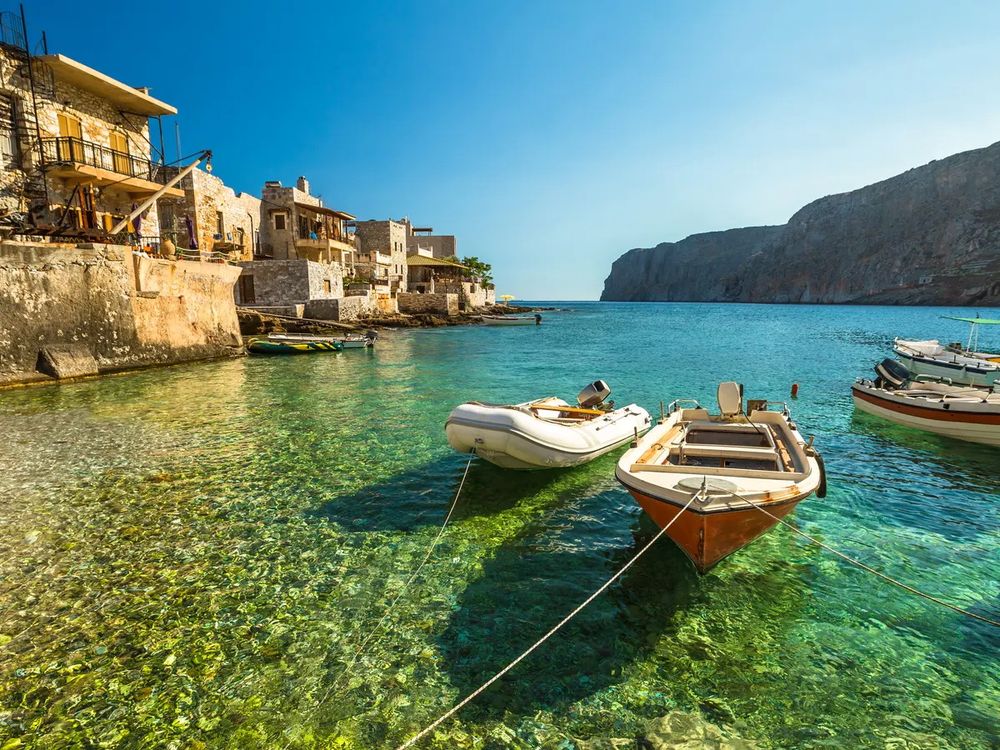Prague Castle has been, for more than 1200 years, the political centre of our state. Today, the president of the Republic resides there and it includes the New Palace, and the so-called Theresa’s Wings (Tereziánská křídla). This structure was consolidated by Niccola Pacassi in the 18th century from individual castle palaces, mainly those from the time of Rudolf II. Matthias’ Gate (Matyášova brána), dating from the year 1614, is a memorial to Rudolf’s successor Matthias II, but the Picture Gallery of Prague Castle still reminds us of Rudolf’s passion for art.
Today, the oldest heart of the castle mainly hosts tourists. The old, medieval Royal Palace harbours Romanesque basements from the 12th century and a Gothic ground floor with the Columned Hall of Wenceslas IV, and the late Gothic throne room Vladislav Hall. The throne room is the work of architect Benedikt Ried, and it replaced three original halls of the Luxemburg Palace and, in its time (1486–1502), created in Europe the largest vaulted area without interior supports (62 x 16 m). Today, the president is elected here and it hosts the most important political ceremonies. Benedikt Ried completed the late Gothic vaults and adjoining riding stairway with Renaissance windows, portals and the Renaissance Ludvík’s Wing. Uniting tradition with the modernity of the day is a constant process. The architect of president T. G. Masaryk, the world renowned Josip Plečnik, carried out many alterations to the castle (1920–34), which sensitively and intelligently make the castle complex unique, and President Václav Havel with Bořek Šípek and Eva Jiřičná are trying to continue in this tradition today.
The true heart of the Czech state and the most sacred place in all of the Czech lands lies in the middle of the main, third courtyard. This is St. Vitus’ Cathedral (katedrála sv. Víta), which incorporates St. Wenceslas’ Chapel (kaple sv. Václava). Here rests the body of the eternal ruler and protector of this land. Above his grave the Crown Jewels have been placed in the crown chambers. The most valuable of which, St. Wenceslas’ Crown, comes from the time of Charles IV (Karel IV). St. Wenceslas’ Chapel, built during Charles IV’s reign by Peter Parler (completed in 1367), shows the significance of this place. Its square ground plan goes against the customary design of a cathedral ground plan at that time. The walls are covered with polished semi-precious stones and frescos, of which the part making up the St. Wenceslas legend comes from the 16th century. The two-metre-high argillite statue of St. Wenceslas (completed in 1373) and the frescos with the emperor’s portrait are from the period of Charles’ reign, as is the extraordinary star-vaulted chapel.
The dominating feature of the southern faćade of the cathedral is the tower topped with a Renaissance gallery and a Baroque “onion” cupola. Between the large southern tower and St. Wenceslas’ Chapel one can find the monumental entrance to the cathedral, called the Golden Gate. It is decorated with a mosaic from the time of Charles IV on which he is portrayed with his fourth wife, Elizabeth of Pommern. It was created in 1371 by Venetian mosaicists according to the design of Czech painters and up until today it is considered to be the largest and oldest outdoor mosaic north of the Alps. After its recent restoration, it is again resplendent in its former beauty. Besides St. Wenceslas Chapel and the Golden Gate with the southern tower, Parler worked on the cathedral presbytery to the Old Sacristy, which has a boldly vaulted ceiling with a suspended apex stone, which for its time (1356) was quite an achievement. The presbytery’s vaulted ceiling is also remarkable; this is one of the oldest webbed vaulted ceilings in Europe (finished in 1385).
In Prague’s cathedral works, after the middle of the 14th century, a late Gothic architectural morphology was born, which about 50 years later expanded throughout all of central Europe. The fact that statue production arose from Parler’s workshops is no less noteworthy. The tombstones of six Premyslian rulers and Bishop Jan Očko of Vlašim in the ground floor chapel, together with a wholly unique collection of 21 portrait busts on the lower triforium and an additional 10 busts of saints on the outer triforium, make the cathedral a magnificent tabernacle of medieval sculptures.
After the death of Peter Parler (1399), construction significantly slowed down and after the outbreak of the Hussite Wars (1420) it completely stopped. In the following one hundred years cathedrals were simply added to. The Jagiellons built a late Gothic royal oratory (1493) and under the Hapsburgs a royal mausoleum was created with the graves of Ferdinand I, and Ann and Maximilian II. The Baroque cathedral was decorated with the silver tombstone of Jan Nepomucký (1733–36). The final construction (1873–1929), which was directed by Josef Mocker (up to the year 1899) and after him Kamil Hilbert, even provided an opportunity for Czech modern artists. That time is represented in the cathedral by the famous Myslbek’s tombstone of Cardinal B. Schwarzenberg (1892–95) or the glass case of F. Kysela, M. Švabinský and A. Mucha. St. Vitus’ is not only a metropolitan cathedral of Prague’s archbishops, but also a coronation cathedral and burial place of our rulers. It was and is a tangible symbol of the Czech state and our faith, because reverence towards St. Wenceslas always united Czech Protestants and Catholics.
Adjoining the southern side is the Old Provost’s Building, which was once the residence of the Prague bishops. On the adjoining side, in the year 1928, the J. Plečnik granite monolith was erected, in honour of the victims of World War I. Further on there stands a bronze replica of the Horse-Mounted Statue of St. George a replica of the original from the year 1373 (located in the National Gallery).
Among the oldest standing structures at Prague Castle is the Benedictine Convent of St. George. The Baroque faćade of its chapel harbours a basilica from the year 920, preserved in the state it was in after its repair in the middle of the 12th century. The convent itself was founded in the year 973. It is the oldest convent in our country and it served as an educational institution for highborn girls of Czech nobility. Along its southern side descends Jiřská Street, which runs along Rožmberk (later Lobkovic) Palace and the Renaissance Burgrave’s Building and heads for the Black Tower (Černá věž) dating from the year 1135. The Black Tower is part of the Renaissance gate, which opens in the direction of the Old Castle Stairs. From Jiřská Street, you can turn off into the quaint Golden Lane (Zlatá ulička). Its picturesque houses are adjoined to the castle’s ramparts. The towers of the ramparts are particularly noteworthy because they served as prisons. The most famous tower is Daliborka, in which, under the Jagiellons, Dalibor of Kozojedy, later made famous by the composer Bedřich Smetana, was imprisoned.
In the nearby surroundings of Prague castle there are various gardens (the Gardens on the Bastion, the Paradise Gardens, the Gardens on the Ramparts, the Deer Moat and the Royal Gardens), which have been growing here since the time of Ferdinand I (since 1534). They harbour a number of Renaissance and Baroque statues from the premier artists of their time (including M.B. Braun) and no less noteworthy structures, such as for example the Renaissance Ball Game Court by Bonifac Wohlmut. This is the oldest walled sports building of this type in Europe (finished in 1569). However, no less interesting is the Renaissance Summer Castle of Queen Ann Jagiellon, called Belvedere, which Ferdinand I (1535–63) had built in the Royal Garden for his wife. The building is decorated with dozens of Renaissance reliefs with historical and courtesan themes. Water tinkles in front of the Summer Castle, spouting from the bronze Singing Fountain dating from the year 1564. The east side of the Royal Gardens connects directly to the Chotek’s Orchards and Letná Plain).
On the opposite side, west of Prague Castle, is Hradčany Square (Hradčanské náměstí). There we find the magnificent courtier and church palaces: Lobkovic Palace (later called Schwarzenberg) with graffiti decoration (1545–63) and the Tuscan baroque palace (finished in the year 1691 by J. B. Mathey). Next to the faćade of the Archbishops’ Palace is a gate leading to Sternberg Palace, in which you can find part of the collection of the National Gallery dedicated to old European art. In the middle of the square stands the late baroque Marian Column from the workshop of F. M. Brokoff (1726) and on the edge of the square, by the corner of Salmovský Palace, a statue of T. G. Masaryk, our first president, was unveiled in the year 2000. The square is the oldest heart of the castle, the third Prague city, which was founded around the year 1320, but it only became a royal city in the year 1598. The smaller city buildings were pushed out by stately palaces of the aristocrats with their luxurious gardens (for example the garden of Černín Palace) and a number of cathedrals, for example the extensive Loreta by K. I. Dienzenhofer (1722). They particularly reflect the style of the quarter New World (Nový svět). Today, most feature Renaissance and early Baroque faćades. With their poetic enchantment, they create a humanising antipole to the stately monumental palaces.
South of Hradčany the Strahov Premonstratensian Cloister, which was founded in the middle of the 12th century, spreads out. After many reconstructions, its most distinct feature is its Baroque face. The extensive buildings serve not only for the Premonstratensian Cloister but also as the National Literature Memorial Building and the rich Strahov Picture Gallery. The library here is especially noteworthy; it contains 130,000 books, 2,500 manuscripts (the oldest of which dates from the 9th century), around 1,500 incunabula, and also the legacy of 1,200 Czech writers. The Strahov complex also contains charming gardens, from which there is a beautiful view of Prague.













